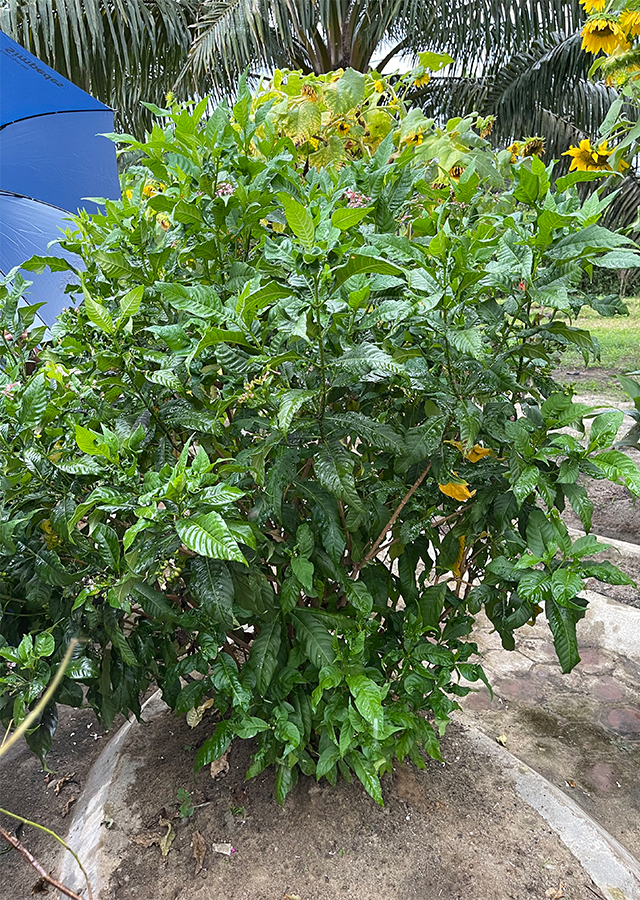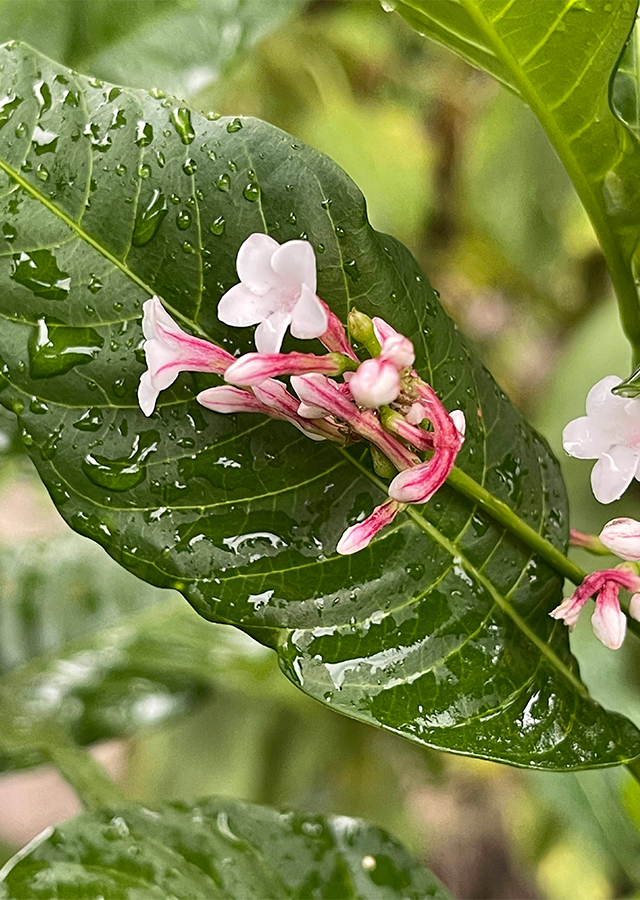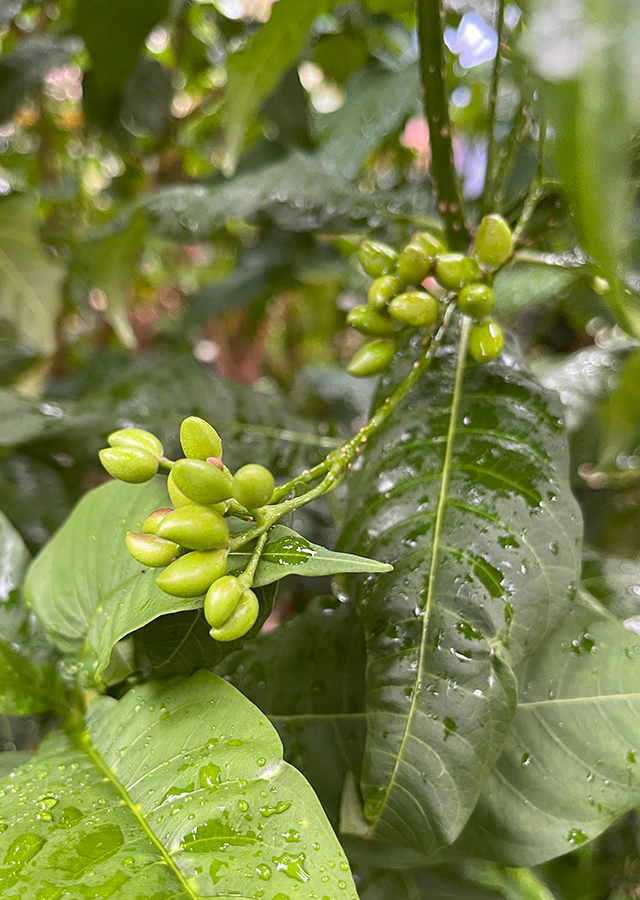Indian Snakeroot
Rauvolfia serpentina (L.) Benth. ex Kurz
Apocynaceae
Location in our garden
Principal



Synonym
Ophioxylon album Gaertn.
Ophioxylon serpentinum L.
Rauvolfia trifoliata (Gaertn.) Baill.
Habitus
Shrubs. An erect, evergreen shrub growing up to 1 m tall from a yellowish rootstock.
Part Used
Leaves
Bark
Roots
Growing Requirements
Full Sunshine
Need Shade
Habitat
Forest
Terrestrial
Overview
Native to the Indian subcontinent and East Asia (from India to Indonesia). Indian snakeroot has been use in India's folk medicine for centuries. The plant has been used medicinally in India for over 2,000 years, being valued especially for its sedative actions and ability to lower the blood pressure. It is commonly harvested from the wild and is also traded. It is a source of compounds that are used in the pharmaceutical industry.
Vernacular Names
She gen mu (Chinese), Arbre aux serpents (French), Indische Schlangenwurzel (German), Indo shaboku (Japanese), Serpentina (Philippines).
Agroecology
This species is a tropical plant and can grow well from the lowlands to an altitude of 1,000 m above sea level. This species is tolerant of various agro-climates, ranging from wet areas such as West Java to extreme dry conditions such as East Nusa Tenggara. It grows best in areas where annual daytime temperatures are in the range of 22 - 30 °C, but can tolerate 4 - 35 °C, as well as average annual rainfall in the range of 1,500 - 3,500 mm, but tolerates 1,100 - 4,500 mm. Likes both full sun and shade condition. Thrives on loamy soils that are fertile and well drained, with a soil acidity (pH) degree in the range of 5.5 - 7, but can tolerate 5 - 7.5.
Morphology
- Stems - with whorled branches and milky sap.
- Leaves - opposite, entire, oblong-elliptic, up to 30 cm long.
- Flowers - white, clustered in axillary cymes, with slender corolla tube and 5 spreading lobes.
- Fruits - small drupe, shiny, black or purple.
- Seeds - one in each fruit, small.
Cultivation
Propagated by seeds and stem cuttings. Seeding should be done as soon as possible, because the dormant period of seeds is very short.
Chemical Constituents
Indole alkaloids (ajmalidine, ajmaline, ajmalinine, ajmalicine, aricine, canescine, coryanthine, deserpidine, isoajmaline, isoserine, isoserpiline, lankanescine, neoajmaline, papaverine, raubasine, raucaffricine, rauhimbine, respinen, respinen , serpentine, serpentinine, thebaine, yohimbine, and yohimbinine), flavonoids, glycosides, cardiac glycosides, phlobatin, resins, saponins, steroids, tannins, triterpenoids, phenols, phytosterols, oleoresins.
Traditional Medicinal Uses
- A medicinal plant of antiquity. Used for millenia inn India. Used to counter the effects of poisoned arrow.
- Used as febrifuge, as stimulant to uterine contractions, for insomnia and insanity.
- Used for high blood pressure.
- For millenia, used as antidote to stings and bites of insects and poisonous reptiles.
- Used in Ayurveda, Unani and folk medicine systems for reducing blood pressure, for its CNS depressant effect, and as hypnotic.
- Ingredient to an Ayurvedic herbal mixture once used in the treatment of schizophrenia.
- In India, referred to as the "insanity herb," used to treat mental disorders, i.e., anxiety, paranoia, nervousness.
- In Siddha medicine, root power given with equal amounts of Triphala powder twice daily is used for hypertension and associated headache and giddiness.
- Root powder given for amenorrhea, oligomenorrhea and dysmenorrhea-like abnormalities.
- For snake bites and scorpion bites, root powder mixed with Piper cubeba and salt applied externally to the bite as well as taken internally.
- For hysteria in women and epilepsy, root powder is mixed with equal amounts of powder of Nardostachys jatamanji.
Part Used
Reference Sources
- Royal Botanic Garden. Plant of the World Online: Rauvolfia serpentina (L.) Benth. ex Kurz. https://powo.science.kew.org/taxon/urn:lsid:ipni.org:names:81648-1. 18-03-22.
- Stuartxchange. 2018. Philippine Medicinal Plants: Serpentina. http://www.stuartxchange.org/Serpentina.html. 18-03-22.
- Flora Fauna Web. 2020. Rauvolfia serpentina (L.) Benth. ex Kurz. https://www.nparks.gov.sg/florafaunaweb/flora/5/8/5894. 18-03-22.
- Tropical Plants Database, Ken Fern. 2021. Rauvolfia serpentina. https://tropical.theferns.info/viewtropical.php?id=Rauvolfia+serpentina. 18-03-22.


